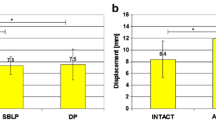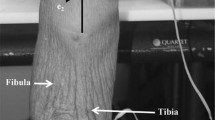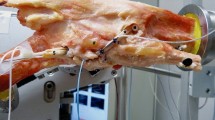Abstract
Purpose
Anterior cruciate ligament (ACL) injury represents one of the most common diagnoses in orthopaedic sports medicine. In the past, anatomic knowledge about the different bundles within the cruciate ligaments triggered new treatment concepts, such as double-bundle ACL reconstruction. Recently, besides complete tearing, partial ACL ruptures and bundle augmentation became a focus. However, only little is known regarding rotational stability of the knee with an isolated torn postero-lateral (PL) bundle. Therefore, the aim of the present study was the torsiometric analysis of tibio-femoral restraint patterns of the PL-insufficient knee joint.
Methods
Fresh human whole body cadavers were enrolled. After diagnostic arthroscopy to ensure the structural integrity of the cruciate ligaments, knee joints underwent torsiometry at 0°, 30°, and 90° degree flexion. Then stepwise the PL bundle and the anteromedial (AM) bundle were arthroscopically resected, while torsiometry of the PL- as well as of the ACL-deficient knee joints was repeated. An area under the curve (AUC) was calculated. All statistical analyses were conducted using a p-value of 0.05 as level of significance.
Results
The comparison of charged and equilibrated curves during internal rotation revealed significant results at low flexion (30° flexion) angles between the ACL intact versus PL absent conditions (p = 0.04). In addition, charged and equilibrated curves during external rotation at 90° flexion, thus high angles, resulted in a significant difference when comparing the ACL-intact with the PL-deficient condition (p = 0.01).
Conclusions
In the present cadaver study using the Torsiometer tool we found a distinct destabilization of the rotational restraints in full knee extension only after total ACL resection. In contrast, no significant findings resulted after an isolated dissection of the PL bundle during internal deflection. Nevertheless, a significant loss of stability was found during unstressed external deflection after isolated PL bundle dissection. Therefore patients, undergoing PL augmentation might benefit regarding rotational instability patterns.


Similar content being viewed by others
References
Gianotti SM, Marshall SW, Hume PA, Bunt L (2008) Incidence of anterior cruciate ligament injury and other knee ligament injuries: A national population-based study. J Sci Med Sport 12(6):622–627. doi:10.1016/j.jsams.2008.07.005
Bjordal JM, Arnly F, Hannestad B, Strand T (1997) Epidemiology of anterior cruciate ligament injuries in soccer. Am J Sports Med 25(3):341–345
Bradley JP, Klimkiewicz JJ, Rytel MJ, Powell JW (2002) Anterior cruciate ligament injuries in the National Football League: epidemiology and current treatment trends among team physicians. Arthroscopy 18(5):502–509. doi:10.1053/jars.2002.30649
Ireland ML (1999) Anterior cruciate ligament injury in female athletes: epidemiology. J Athl Train 34(2):150–154
Mountcastle SB, Posner M, Kragh JF Jr, Taylor DC (2007) Gender differences in anterior cruciate ligament injury vary with activity: epidemiology of anterior cruciate ligament injuries in a young, athletic population. Am J Sports Med 35(10):1635–1642. doi:10.1177/0363546507302917
Li X, Xu CP, Song JQ, Jiang N, Yu B (2013) Single-bundle versus double-bundle anterior cruciate ligament reconstruction: an up-to-date meta-analysis. Int Orthop 37(2):213–226. doi:10.1007/s00264-012-1651-1
Muller B, Hofbauer M, Wongcharoenwatana J, Fu FH (2013) Indications and contraindications for double-bundle ACL reconstruction. Int Orthop 37(2):239–246. doi:10.1007/s00264-012-1683-6
Suomalainen P, Kannus P, Jarvela T (2013) Double-bundle anterior cruciate ligament reconstruction: a review of literature. Int Orthop 37(2):227–232. doi:10.1007/s00264-012-1680-9
Petersen W, Zantop T (2007) Anatomy of the anterior cruciate ligament with regard to its two bundles. Clin Orthop Relat Res 454:35–47. doi:10.1097/BLO.0b013e31802b4a59
Zantop T, Herbort M, Raschke MJ, Fu FH, Petersen W (2007) The role of the anteromedial and posterolateral bundles of the anterior cruciate ligament in anterior tibial translation and internal rotation. Am J Sports Med 35(2):223–227. doi:10.1177/0363546506294571
Markolf KL, Mensch JS, Amstutz HC (1976) Stiffness and laxity of the knee—the contributions of the supporting structures. A quantitative in vitro study. J Bone Joint Surg Am 58(5):583–594
Takeda Y, Xerogeanes JW, Livesay GA, Fu FH, Woo SL (1994) Biomechanical function of the human anterior cruciate ligament. Arthroscopy 10(2):140–147
Butler DL, Noyes FR, Grood ES (1980) Ligamentous restraints to anterior-posterior drawer in the human knee. A biomechanical study. J Bone Joint Surg Am 62(2):259–270
Komzak M, Hart R, Okal F, Safi A (2012) Does the posterolateral bundle influence rotational movement more than the anteromedial bundle in anterior cruciate ligament reconstruction?: a clinical study. J Bone Joint Surg (Br) 94(10):1372–1376. doi:10.1302/0301-620X.94B10.28673
Komzak M, Hart R, Okal F, Safi A (2013) AM bundle controls the anterior-posterior and rotational stability to a greater extent than the PL bundle—a cadaver study. Knee 20(6):551–555. doi:10.1016/j.knee.2013.03.012
Papalia R, Franceschi F, Zampogna B, Tecame A, Maffulli N, Denaro V (2014) Surgical management of partial tears of the anterior cruciate ligament. Knee Surg Sports Traumatol Arthrosc 22(1):154–165. doi:10.1007/s00167-012-2339-1
Yagi M, Kuroda R, Nagamune K, Yoshiya S, Kurosaka M (2007) Double-bundle ACL reconstruction can improve rotational stability. Clin Orthop Relat Res 454:100–107. doi:10.1097/BLO.0b013e31802ba45c
Alam M, Bull AM, Thomas R, Amis AA (2013) A clinical device for measuring internal-external rotational laxity of the knee. Am J Sports Med 41(1):87–94. doi:10.1177/0363546512469874
Mayr HO, Hoell A, Bernstein A, Hube R, Zeiler C, Kalteis T, Suedkamp NP, Stoehr A (2011) Validation of a measurement device for instrumented quantification of anterior translation and rotational assessment of the knee. Arthroscopy 27(8):1096–1104. doi:10.1016/j.arthro.2011.02.034
Ahrens P, Kirchhoff C, Fischer F, Heinrich P, Eisenhart-Rothe R, Hinterwimmer S, Kirchhoff S, Imhoff AB, Lorenz SG (2011) A novel tool for objective assessment of femorotibial rotation: a cadaver study. Int Orthop 35(11):1611–1620. doi:10.1007/s00264-010-1159-5
Prins M (2006) The Lachman test is the most sensitive and the pivot shift the most specific test for the diagnosis of ACL rupture. Aust J Physiother 52(1):66
Gabriel MT, Wong EK, Woo SL, Yagi M, Debski RE (2004) Distribution of in situ forces in the anterior cruciate ligament in response to rotatory loads. J Orthop Res 22(1):85–89. doi:10.1016/S0736-0266(03)00133-5
Monaco E, Maestri B, Labianca L, Speranza A, Kelly MJ, D'Arrigo C, Ferretti A (2010) Navigated knee kinematics after tear of the ACL and its secondary restraints: preliminary results. Orthopedics 33(10):87–93. doi:10.3928/01477447-20100510-58
Christel PS, Akgun U, Yasar T, Karahan M, Demirel B (2012) The contribution of each anterior cruciate ligament bundle to the Lachman test: a cadaver investigation. J Bone Joint Surg (Br) 94(1):68–74. doi:10.1302/0301-620X.94B1.26562
Furman W, Marshall JL, Girgis FG (1976) The anterior cruciate ligament. A functional analysis based on postmortem studies. J Bone Joint Surg Am 58(2):179–185
Nielsen S, Ovesen J, Rasmussen O (1984) The anterior cruciate ligament of the knee: an experimental study of its importance in rotatory knee instability. Arch Orthop Trauma Surg 103(3):170–174
Messner K, Maletius W (1999) Eighteen- to twenty-five-year follow-up after acute partial anterior cruciate ligament rupture. Am J Sports Med 27(4):455–459
Bak K, Scavenius M, Hansen S, Norring K, Jensen KH, Jorgensen U (1997) Isolated partial rupture of the anterior cruciate ligament. Long-term follow-up of 56 cases. Knee Surg Sports Traumatol Arthrosc 5(2):66–71
Steckel H, Vadala G, Davis D, Musahl V, Fu FH (2007) 3-T MR imaging of partial ACL tears: a cadaver study. Knee Surg Sports Traumatol Arthrosc 15(9):1066–1071. doi:10.1007/s00167-007-0337-5
Yao L, Gentili A, Petrus L, Lee JK (1995) Partial ACL rupture: an MR diagnosis? Skelet Radiol 24(4):247–251
Acknowledgements
We would like to explicitly thank Fritz Seidl, MA Interpreting and Translating, for his excellent language copyediting.
Conflict of interest
This study has been supported by a grant from the Deutsche Arthrose-Hilfe e.V. (Frankfurt am Main, Germany).
There is no conflict of interest.
Author information
Authors and Affiliations
Corresponding author
Additional information
Stephan Lorenz and Philipp Ahrens contributed equally to this work.
Rights and permissions
About this article
Cite this article
Lorenz, S., Ahrens, P., Kirchhoff, S. et al. Dynamic quantification of tibio-femoral rotation in postero-lateral bundle insufficiency of the anterior cruciate ligament: a cadaver study. International Orthopaedics (SICOT) 39, 865–870 (2015). https://doi.org/10.1007/s00264-014-2537-1
Received:
Accepted:
Published:
Issue Date:
DOI: https://doi.org/10.1007/s00264-014-2537-1




